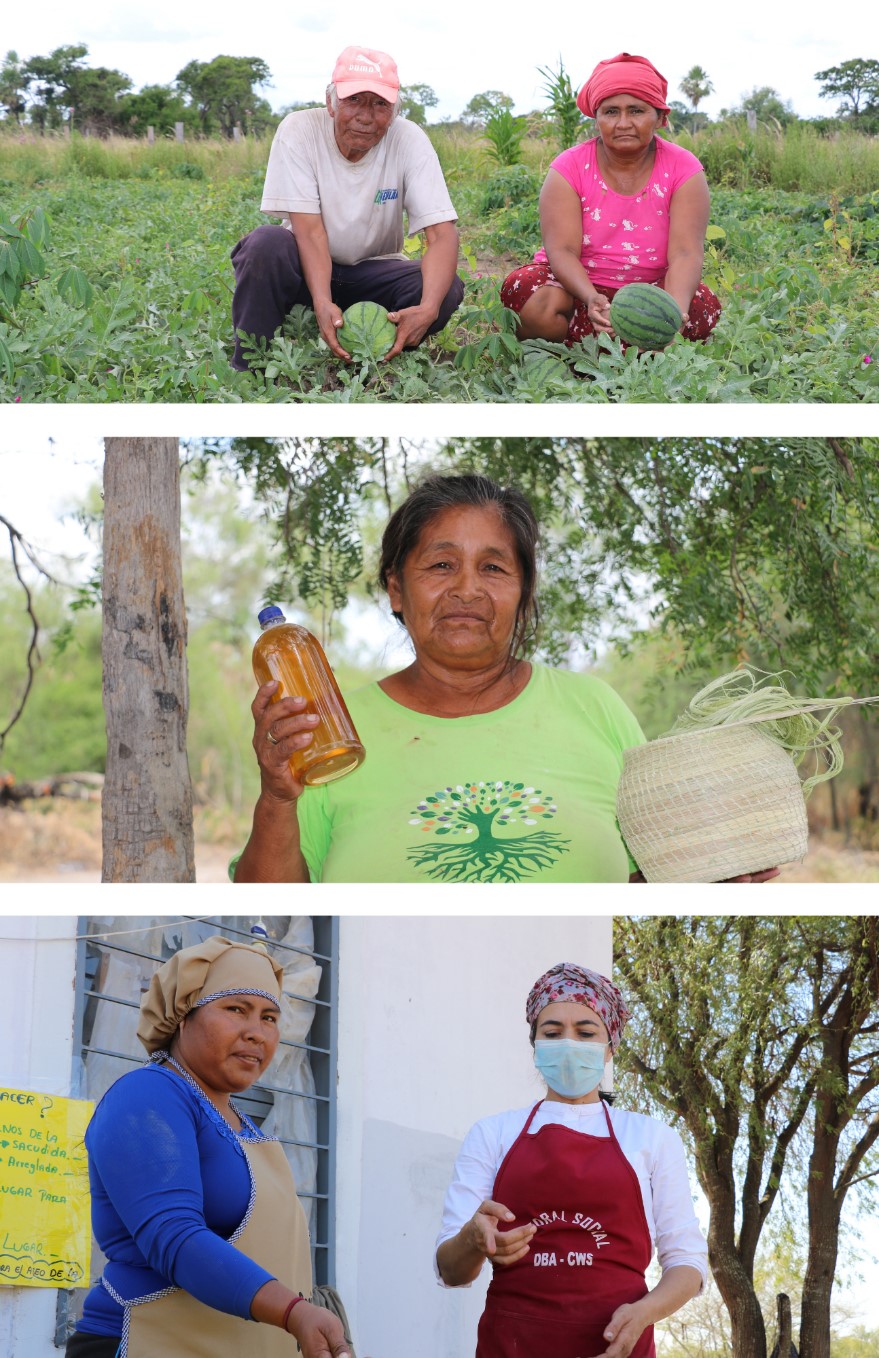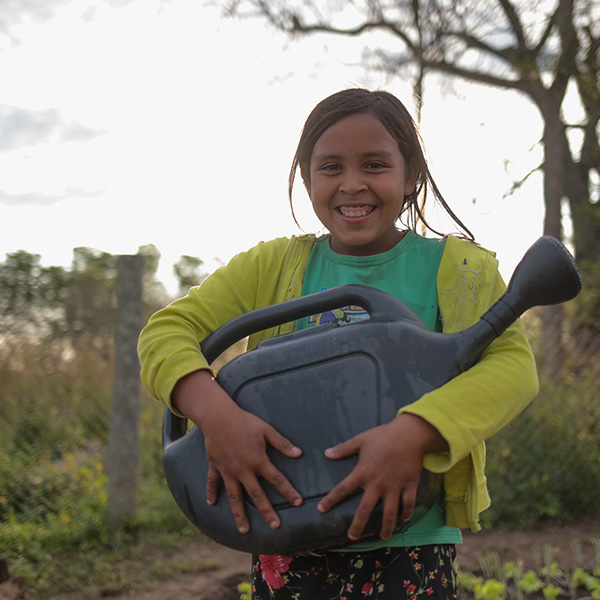Indigenous communities in Paraguay’s Bajo Chaco region are strengthening their resilience through sustainable farming, leadership development, and climate adaptation. With support from CWS and local partners, families are overcoming challenges like drought while building a more secure future. In Paraguay, families are forging a more resilient future. Through the Comprehensive Rural Development Project, nine indigenous communities in the Bajo Chaco …
Stories of Change

Top: Mariza Galeano, Middle: Workshop and human rights, Bottom: Mariana Ayala
“Women in this community seem to have awakened from a long sleep”
Mariana Ayala is a mother, grandmother, organizer and leader of the women in her community, Sawhoyamaxa, home to Enxet people in the Gran Chaco region of Paraguay. She has attended all training and workshops organized by CWS’ local partner, Pastoral Social Diocesana Benjamin Aceval (PSDBA), in her community and today plays a key role in both, motivating women to attend workshops, meetings and assemblies and use the new knowledge at home, farms and communities.
Recently, Mariana and other experienced women leaders were asked to share their stories and lessons with individuals from neighboring communities where the women’s empowerment training was about to begin. The goal of the training is to strengthen the bonds between women within the same village, enhance women’s leadership and promote an exchange of knowledge and mutual empowerment.
In her remarks, Mariana said, “I am happy to share my testimony with the women living in these communities. I want to encourage you to fight for our rights because we have Law 904/81, which establishes the statute of Paraguayan indigenous communities on our side, and we must use it as our tool.”
Mariana, who witnessed the historic struggle of women for land, proudly recalled, “We managed to recover our ancestral lands thanks to the bravery of women. Surely, you know or have heard of my community, Sawhoyamaxa.”
With heartfelt sincerity, she shared the reason for her sacrifice to be present that day: “I am an older woman now. I was very happy when I received last week the invitation to come here today. I immediately accepted. Last night, I barely slept until 2:00 AM, taking care of a sick person. Few people have the patience to care for the sick, but we must be patient with others. I almost didn’t come today, but here I am, happy to see you all. This is my first visit to Buena Vista, and I come with the spirit to encourage you all so that together we can advance in defending our rights and developing our communities.”
Mariana is one of many inspiring stories. Mariza Galeano, a mother, grandmother and a leader among the women of the Yakye Axa village also participated in the training process carried out by PSDBA over the years and in her remarks to the women of Villa Nueva she said, “I want to share how happy I am with the Pastoral Social. Thanks to the training and workshops, the women in my community seem to have awakened from a long sleep. Now, we know our rights, we want them to be respected, and we strive to ensure our rights are upheld. We attend community meetings, participate, raise our voices and request things for the community because women have a different perspective from men. We better understand the needs of the community.”
Mariana Ayala and Mariza Galeano represent the voices of women in their villages and have become beacons of hope and determination for all rural women fighting for a more just and equitable future.
This program is supported by our local partner, Pastoral Social Diocesana Benjamin Aceval (PSDBA), with the financial support of Growing Hope Globally. To learn more about our work in Latin America, click here.
Stories of Change

Top: Alodia and Cristobal in their garden where they have grown their own watermelons. Middle: Estelvina, producer of honey and handcrafts. Bottom: Women in training on planting seeds and food production
Paraguayan Indigenous Communities are Seeding Knowledge
Studying is opening a door of possibilities for people in the Lower Chaco region (Paraguay). The indigenous women of this region tell us about their achievements.
One of the greatest wishes of Teresa Benítez, a resident of El Espinillo, Paraguay, is “to study, to know the letters A, B, and the other letters as well.” She is 76 years old, plants vegetables, produces honey and lives with her husband and two children in El Espinillo.
Jorgelina Flores and a group of women from the Yakye Acá community have expressed the same need: “We want to read and write, and not die doing our signature with fingerprints.” And in the Sawhoyamaxa community, Mariana Ayala comments that “it is time to wake up and assert our rights for the education of our children.”
These women are all part of the project called “Comprehensive Rural Development in Indigenous Communities of the Lower Chaco region, in Paraguay.” The program is implemented by CWS through our local partner, Pastoral Social Diocesana de Benjamín Aceval, with the support of Growing Hope Globally.
The program includes planting trees, digging wells in low water areas, indigenous health and other vital aspects for the communities of the region. There is also training in human, civil and political rights, agriculture and beekeeping production.
Before participating in the training on planting seeds and food production, Alodia González did not know how to create income for her family. With knowledge on agriculture and beekeeping, she led the production process of the community garden and began to make honey.
The honey production process began in September 2021 and ended with the last harvest in February 2022.
“With a good production of honey, we are generating significant economic income to support our families. We harvest the honey from the bee boxes and sell it here in the community, or we manage to sell it at fairs in Asunción [Paraguay’s capital],” Alodia said. She added that “with the garden, we are able to eat lettuce, parsley and other vegetables produced by us.”
In 2021 the hot season damaged the orchards and delayed the growth of the planted vegetables. Despite this, the planting of fruit trees (390) such as lemon, orange, tangerine, grapefruit and mango was able to start again shortly after.
Alodia’s community also received wire mesh to fence the community garden. They also got tools, seeds, and technical assistance for the preparation of food from cultivated products. In total, 11 orchards were activated with the participation of 75 families.
These activities take place in six indigenous communities: San Fernando, Laguna Pato, Monte Alto, Espinillo, Yakye Axa and Sawhoyamaxa.
“We save our seeds, and now all the seeds that we planted and collected last year are growing,” Herminia González says. She is an agricultural producer from the Lolaico Guasu village, in Laguna Pato community.
One of the biggest challenges continues to be the lack of water for human consumption and production during long periods of drought. Thus, to increase the number of water sources in 15 villages, 24 shallow wells were dug. Ten of these shallow wells will supply the most affected communities in drought and scarcity of rainwater. A total of 301 families benefited.
“For education to improve in all communities, we must all unite,” Leonardo Martínez said. He is one of the leaders of the village 26 de Junio, Espinillo.
As part of the project, 520 families also receive support and donations, given the necessities for the pandemic. 12 kg non-perishable food items have been donated in places where access is most difficult because there are no roads.
This year, one of the goals of Pastoral Diocesana de Benjamín Aceval is to continue empowering community members so that they can self-manage their productions and crops.
Beekeeping: an unexpected lifeline in Paraguay
July 8, 2020
Indigenous communities have lived in the Gran Chaco region of Paraguay for centuries. And for most of that time, families had lots of ways to earn a living. They hunted, fished, ate local fruits, consumed local honey and made crafts. This lifestyle was largely possible because they could move freely across the vast region. It wasn’t an easy way of …
Women’s Right to Water: a “Learning Route” in Argentina
Agustina Ramos Mejia | March 3, 2020
It was the end of October, and spring had just started in Argentina. In the Gran Chaco region, though, it felt like the middle of summer as the temperature easily reached 110° F. We were in Orán, a town in the province of Salta in the Gran Chaco. Thirty women got together to exchange experiences and learn new technologies for …
Stories of Change

Mercedes Benitez, 10, stands in the community garden in her Sanapaná community in Paraguay. Photo: Sean Hawkey
A more hopeful new chapter in Paraguay
The average farm in the United States is about 443 acres. In rural Paraguay, a 2,500-acre farm is considered to be small to medium scale.
This vast area is known as the Gran Chaco. For most of its history, this land has been home to indigenous communities. The Sanapaná and other indigenous groups were nomadic, hunting, gathering and fishing in the largely untouched natural areas.
In recent years, however, these wide-open spaces have become home to giant commercial farms. Massive corporations have bought hundreds of millions of acres that they are using to farm genetically modified soya and corn, which is then exported. Many of those harvests end up as livestock feed in China, for example.
Meanwhile, the Sanapaná have had their movement severely restricted. As the area has increasingly been divided into parcels of private land, less and less is left for its original inhabitants. They end up living, quite literally, on the fringes of society. Some have tried to make a home on bits of land on the side of the road. Others have had their communities surrounded by private farms and end up cut off from the rest of the world.
And with their freedom of movement goes their ability to provide for themselves the way that they have for generations. They can no longer travel to their traditional hunting and fishing grounds. The precious natural environment is also suffering or being destroyed by the commercial giants.
Sanapaná families have struggled to adapt. Some have found occasional work as laborers on nearby farms. For the most part, though, they are still trying to survive by hunting and fishing, but nutrition and food security have suffered. Many families rely on traveling food salesmen to feed their families, but the food is overpriced, especially compared to their low incomes.
We recognize that the Sanapaná are in an unfair and difficult situation. So, alongside our partners, we joined these indigenous families in 2018 to help overcome food insecurity and the other challenges that come with isolation and marginalization. Now, we’re working with the Ministry of Health to make sure doctors can visit these communities. Also, a water consultant is helping indigenous communities create custom proposals so that they can advocate to the local or national government for more support for water and agriculture.
And then there are the gardens.
We’re connecting the Sanapaná people to agricultural experts and the tools they need to set up public gardens. These gardens provide a space for indigenous families to learn about and experiment with growing different types of vegetables in their local climate. Despite setbacks from flooding and droughts, families have enthusiastically taken to the gardens. They represent a new way for families to put food on the table despite having such relatively restricted land access.
The Sanapaná story is a sad one, filled with destruction, vulnerability and marginalization. By working together, however, we’re helping them turn the page into a new, more hopeful chapter.
Thanks to Growing Hope Globally for their support of the next few years of this program.
